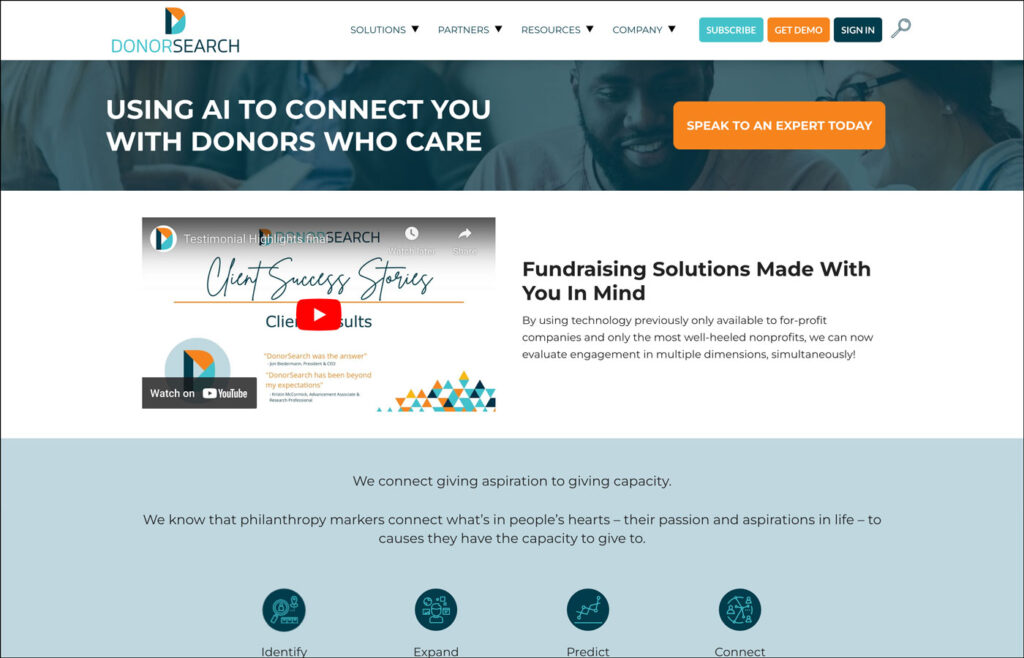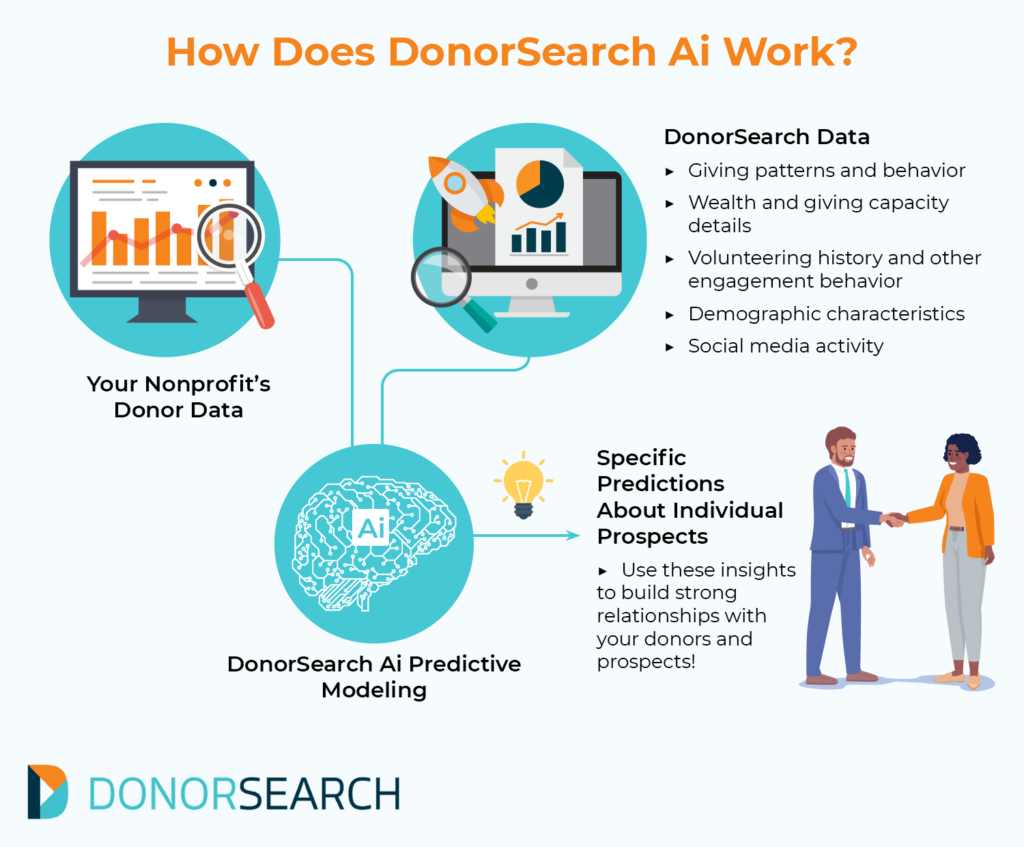
AI For Nonprofits: Everything Your Org Needs to Know
There’s been a lot of buzz lately around the topic of artificial intelligence (AI), especially with the rise of generative AI breakthroughs like ChatGPT, Google Bard, Microsoft Bing’s open AI tool, and many others.
But along with the excitement about ChatGPT and other AI tools, many questions have surfaced about the role of AI in our society. On top of ethical and economic concerns, organizations everywhere are asking, “How can we use AI to improve what we do?”
Nonprofits are among these organizations looking to learn how AI can help them with everything from data management and donor screening to fundraising campaign optimization. However, it can be daunting to know where to start.
In this short guide, we’ll help you navigate the world of AI for nonprofits. Specifically, we’ll cover:
- AI For Nonprofits: FAQs
- 11 Ways to Use AI in Nonprofit Work
- DonorSearch Ai: The Most Advanced Machine Learning Solution for Nonprofits
When you have the right AI tools on your side and you know how to use them to optimize your nonprofit’s operations, you’ll have more time to get back to the nonprofit work that will always require a human touch—building and maintaining relationships with your supporters and beneficiaries so that you can move your mission forward. Let’s dive in!

AI For Nonprofits: Frequently Asked Questions
To set your nonprofit up for success with AI-powered tools, you’ll need to understand the fundamentals of AI. Get your bearings by reviewing these frequently asked questions:
What is artificial intelligence?
Artificial intelligence (AI) is the ability of a machine (like a computer) to “think” like a human and perform tasks like recognizing patterns, processing information, drawing conclusions, and making recommendations.
While there’s been a lot of focus recently on ChatGPT as the hot new AI tool, in reality, AI has been a part of our everyday lives for a long time. Here are some examples:
- Social media algorithms personalizing the posts you see in your feed
- Digital voice assistants like Siri or Alexa answering your questions or helping you perform tasks like adding items to a grocery list
- Companies like Amazon or Netflix giving you recommendations for what to buy or watch next based on your past behavior on their platforms
- 24/7 customer service chatbots on various businesses’ websites helping to answer your questions or guide you to the right information
- Navigation tools like Google Maps or Apple Maps helping you navigate to your destination and giving you traffic updates
As you can see, humans and AI have coexisted for a long time. But now, as AI gains even more popularity, your nonprofit has the opportunity to use it to automate a number of tasks and expand your human team’s capacity to do more for your cause, especially when it comes to fundraising.
What is machine learning?
As you learn more about AI, you’ll probably see the term “machine learning” pop up. Machine learning is simply the process of how an AI tool develops its intelligence.
And an AI tool can get smarter at its job over time, just like a child who learns their ABCs gets better at recognizing letters as they practice.
For example, the more you use a social media platform like Instagram, the better the tool’s AI capabilities will be able to predict what types of content you want to see more of. Likewise, DonorSearch’s AI tools get better at making predictions about prospects over time as you use the tool over and over again.
How does AI work?
There are two key ingredients that AI tools need to do their job:
- A large amount of data: The beauty of AI is that it can handle looking at, analyzing, and making predictions from copious amounts of information!
- A carefully-created algorithm: These are mathematical models that the AI tool will use to analyze the data—algorithms give the AI tool its “instructions” for completing the task at hand.
When it comes to using AI for your nonprofit, you’ll likely leverage your donor data quite a bit. Prepare your organization to gain accurate actionable insights from AI tools by ensuring your data is up-to-date. Follow data hygiene best practices like deleting duplicates, updating outdated information, and filling in gaps.
What are some popular AI tools for nonprofits?
There are a number of useful AI tools out there for nonprofits to leverage in a fundraising intelligence strategy (when used responsibly). Here are some top choices:
- DonorSearch Ai: DonorSearch Ai is the leading prospect research tool that combines your nonprofit’s data with DonorSearch’s massive data array, and then builds cutting-edge predictive models to help you identify your very best prospects with a high degree of accuracy. Learn more about DonorSearch Ai below!
- ChatGPT, Bard, and Bing: These generative AI models can help you be more efficient with a number of tasks, from creating a first draft of an email to brainstorming how to explain complex concepts in your communications.
- Grammarly: Grammarly helps you improve your writing as you go, whether you’re typing an email or working on a Google doc.
- Canva: Canva is a user-friendly graphic design platform that now offers a free online AI image generator. Simply enter a text prompt and watch the tool create an image that you can then enhance.
- Synthesia: Synthesia allows you to easily create professional videos for your organization that feature AI avatar narrators.
- FeedHive: FeedHive allows you to easily create, schedule, and publish social media content. It can also help you optimize your posts for maximum engagement and recycle content in new and interesting ways.
As you consider how to incorporate AI into your nonprofit’s operations, choose tools that are user-friendly and scalable, but that also prioritize trust, privacy, and security. Using AI responsibly will help ensure that new additions to your toolkit aren’t slowing your team down or leading to a lag in organizational growth.
Is AI going to replace human nonprofit professionals?
There’s a lot of talk (and worry!) about AI rendering human jobs obsolete. After all, if a machine can do your job for you, does your organization need you anymore?
While society is still getting its footing with AI and the future isn’t certain, the fact is that when it comes to nonprofit work, AI is most likely only going to enhance the work that humans are doing at your organization. After all, nonprofit work requires people who bring the following to the table:
- Human empathy and the ability to connect with other people
- Strategic decision-making
- Consideration for ethics
- Adaptability and innovation
- Complex problem-solving skills
For example, say you use DonorSearch’s AI tools to identify new prospects for an upcoming fundraising campaign. Although the tool can do the research footwork for you with a high degree of precision, your team still has the job of building a genuine relationship with each prospect the tool helps you find! With AI, you always need to keep human relationships front and center.
So, the moral of the story: don’t fear AI. Instead, embrace it and use it responsibly. It frees up your team’s time, energy, and headspace to tackle the more complex tasks that can’t be left to robots and algorithms.
11 Ways to Use AI in Nonprofit Work
AI has a wide range of applications, especially for nonprofits. In this section, we’ll explore some use cases for AI tools. Keep in mind that as AI becomes more ubiquitous in our society, the options for how your organization can use it will only increase!
1. Screen Donors, and Predict Donor Behavior
Donors and their generosity fuel your nonprofit’s work. This is why the prospecting and screening processes are so essential for your organization—they help you find the individuals who are ready and willing to give.
AI tools (like DonorSearch Ai—more on this below) can process your donor data along with a wide spectrum of external wealth and philanthropic data in order to make predictions and recommendations about who is most likely to give, when they’re going to give and how frequently, how much they’re going to give, and the best approach for reaching out to them.
With this information on your side, you can hone your outreach work so that it’s tailored to each individual and sets you on the path to not just secure one donation, but build a lasting relationship that will lead to continued giving and engagement.
2. Direct Online Giving
Sometimes all a donor needs is a nudge in the right direction to give online. AI makes it easier than ever for donors to find causes they believe in and decide what to contribute to.
For example, with its algorithms, Facebook can make personalized recommendations for charitable giving. According to the Facebook Help Center, here’s how it works: “To provide our charitable giving products, we collect data about how users and their friends use and engage with our fundraising features, such as previous donation amounts, user proximity to nonprofits or whether a user created a fundraiser. We use this data to personalize and improve users’ experiences and our products, such as suggesting that a user start a fundraiser.”
AI can also make the donation experience easy and painless. For instance, a donor can ask Alexa to send a payment to the charity of their choice. The donor doesn’t even have to lift a finger.
3. Automate Routine Tasks
It’s no secret that there are a lot of moving parts to manage when it comes to running a nonprofit, especially if yours is a small or medium-sized shop. Your team likely spends a lot of its time completing tasks such as:
- Collecting and analyzing data
- Reviewing and updating donor prospect profiles
- Reading and responding to incoming communications
- Scheduling meetings
- Sending internal and external reminders
AI can automate these tasks for your team, not only freeing up their time to focus on more important work but also reducing the risk of human error.
4. Keep in Touch
AI-powered chatbots can work on your website to answer common website visitor questions. For example, a donor might ask about how to make a donation, or a beneficiary might ask about how to access your services.
The best thing about chatbots is that they’re on the job 24/7, so they’re always available as a resource for anyone who visits your website at any time of the day.
5. Personalize Donation Appeals
Especially as your nonprofit’s community grows, it can be difficult to find the time to personalize every donation appeal. However, in order for a donation appeal to resonate with a donor, it has to demonstrate that your nonprofit sees and values them as an individual committed to your cause, especially when it comes to requesting a major gift.
AI can help by assisting you in quickly analyzing donor data to create appeals based on communication preferences, giving history, and specific interests. Additionally, AI tools can help you automate the creation of written appeals and quickly deliver them to donors so you can keep your campaigns moving!
6. Manage and Analyze Social Media Engagement
Social media is a great place to regularly interact with your nonprofit’s supporters, promote your fundraising campaigns, and keep them informed about your organization’s progress toward accomplishing its mission. You can use AI-powered social media management tools to:
- Analyze social media trends
- Make content recommendations
- Write post text, image captions, and hashtags
- Schedule your posts
- Recycle content so you can re-share core information about your cause
- Monitor engagement on multiple platforms
When you free up your team’s time from having to handle all the little things that go into each and every social media post, you can fine-tune your larger social media strategy to help your organization better engage its community.
7. Detect Fraud
AI algorithms can look at your data and understand what a typical financial transaction, donation, or grant distribution looks like for your nonprofit. This way, any deviation from the norm will be flagged so that your team can double-check that everything is correct.
Algorithms trained to understand language can also pick up on any suspicious, fraud-indicative language in written communication like emails, chat logs, or donation forms.
As a result, your nonprofit can keep its information and resources safe, maintain transparency with supporters, and continue doing good for your community without having to sort through sticky situations.
8. Manage Data
Having accurate, usable data is essential for your nonprofit to make informed decisions. And with AI, there’s no reason for a staff member to spend hours going through spreadsheets or digital records to make sure everything is in tip-top shape. Use AI to:
- Clean and organize your datasets
- Integrate data from multiple sources
- Detect security threats
- Generate data visualizations
As your nonprofit organization grows, it will be important for you to be able to manage your data at scale. AI tools can make the process a lot easier.
9. Evaluate Programs
Wondering how well your new after-school music program is doing at making a difference in beneficiaries’ lives? Or are you curious about how your animal shelter’s foster program is performing and whether it’s leading to more adoptions?
AI can help you evaluate your programs by analyzing your data to identify program outcomes, assess effectiveness, understand sentiment around the programs, and identify potential improvements. You can then use these insights to make your programming more efficient and effective for those who participate.
10. Plan Events
Planning a nonprofit event is a big job, especially when you want to create a memorable experience that will not only pull in more support for your mission but also bring your entire community closer together.
Use AI to streamline the planning experience. It can help you:
- Analyze location, capacity, amenities, and costs to select the right venue for your event
- Consider attendee preferences, availability, and potential conflicts when selecting the date of the event
- Analyze historical event data and current costs to design your event budget
- Use the best communication channels, personalize messages, and target certain groups to promote the event
By using supporter data to design your events, you’ll be able to better plan experiences that people will be excited about and maximize attendance.
11. Manage Volunteers
Volunteers often power nonprofits’ ability to deliver their services and programming. AI can help optimize their experience with your organization, too.
For example, you could use AI tools to match volunteers with opportunities you know that they’ll enjoy based on their volunteering history and personal interests. You could also use AI to schedule your volunteers, communicate with them, and create personalized thank-yous for their hard work.
DonorSearch Ai: The Most Advanced Machine Learning Solution for Nonprofits

DonorSearch’s AI tool is the most advanced machine learning tool available to the nonprofit sector. Through predictive modeling, DonorSearch Ai can help nonprofits identify and segment top prospects with extreme accuracy. Plus, it’s a solution that is scalable and user-friendly.
How does DonorSearch Ai work?

DonorSearch brings together your nonprofit’s current data as well as information about individual prospects’:
- Giving patterns and behaviors
- Consumer information, wealth details, and charitable giving capacity
- Volunteer history and other engagement behavior unique to your organization
- Demographic characteristics from nationally-compiled datasets
- Circles of influence and social media activity
This means that DonorSearch Ai is built to help your nonprofit connect with donors who aren’t just able to give to your nonprofit but who are passionate about your cause.
Next, DonorSearch Ai analyzes this data to make specific predictions about individual prospects, such as:
- Who is going to donate in the next 12 months
- Who is likely going to make their first donations
- Who is likely to make a recurring gift
- Who is likely to give over $250
- Who is likely to give the most over their lifetime
In addition, DonorSearch Ai can make tailored suggestions for how to begin reaching out to a prospect.
DonorSearch Ai utilizes the latest deep learning and machine learning capabilities, which means that the AI models constantly improve over time as they learn more about the characteristics of your donors.
Want to see how the next-generation solutions at DonorSearch have made a difference for nonprofits, higher education institutions, and healthcare institutions? Check out our success stories!
Final Thoughts
AI is here to stay, and with its powerful capabilities, your nonprofit can free up time to focus on what matters most: the mission you serve and the people whose generosity powers that mission.
As you consider the many AI tools available for nonprofits, keep DonorSearch Ai at the top of your list. Its cutting-edge functionality and leading commitment to responsible AI will put you a step ahead in the fundraising game and help you connect with more people who are ready to give to your specific organization.
Looking to learn more? Check out these additional resources:
- Legacy Gifts: Taking Your Org’s Strategy to New Heights. Setting up a legacy gift is a great way for a donor to make a lasting impact on your cause. Learn how to create a legacy gift program and promote it in this guide.
- Creating Perfect Donor Prospect Profiles: A Guide & Template. Thorough, up-to-date prospect profiles are essential for effective fundraising. Get our profile template and learn everything you need to know in this resource.
- Building a Gift Range Chart: A Quick Guide & Template. A gift range chart can help guide your fundraising efforts. Learn how to build your own in this short guide.

